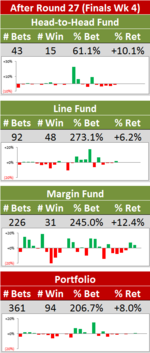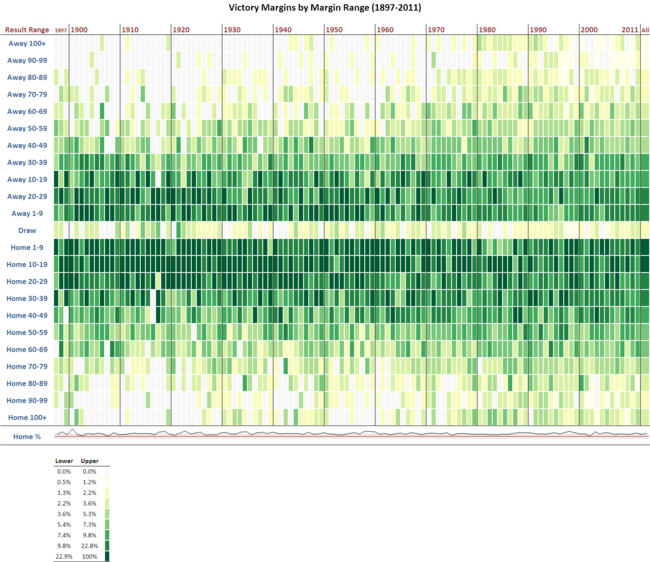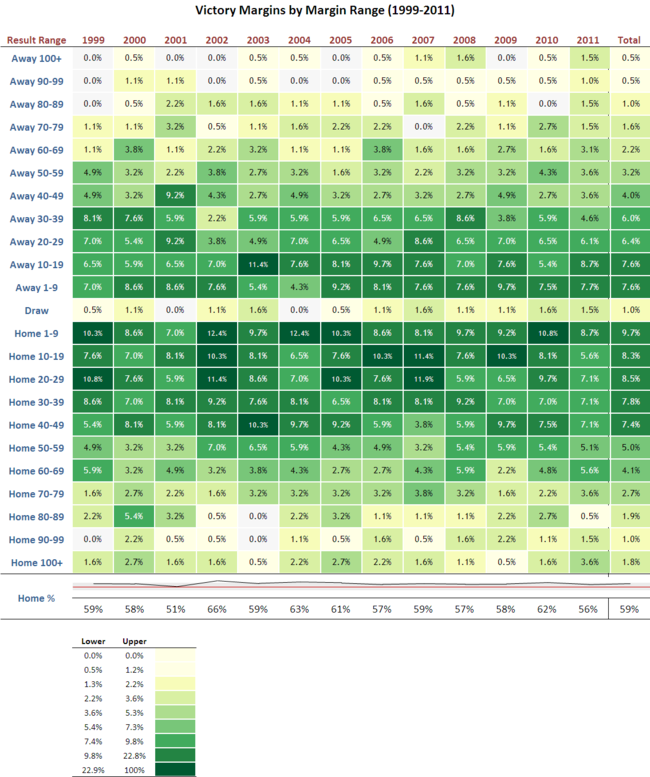Margins of Victory Across the Seasons
 Saturday, January 14, 2012 at 6:14PM
Saturday, January 14, 2012 at 6:14PM This year MAFL Investors will be taking on the TAB bookmaker in a new arena by attempting to pick the final victory margin for each game within a 10-point range. Having not wagered in this market I've no bedrock of intuitions - nor misconceptions - about it yet; I thought I'd start with a little historical analysis.
(Please click this image to access a larger version of it.)
The graphic - produced using the excellent Sparklines for Excel product - shows, for every season, the proportion of games in that season that finished with a victory margin in a specified range. The darker the green in a cell the larger the proportion of games that finished with the relevant victory margin.
At a macro level, it's evident that most games in most seasons have been fairly close, with victory margins below 40 points dominating. It's also clear that Home teams have been more likely to produce victories of 30 points or more than have Away teams. (Note that I've used the AFL designations to determine home team status in every game.) Across the entirety of the competition, the most common victory margin ranges have been Home wins by 1-9 points and Home wins by 10-19 points.
One other that stands out for me in this chart is the fact that blowout victories - those by 100 points or more - are largely a phenomenon of the late 1970s and beyond, especially for Home teams.
The line at the bottom of the graphic tracks the winning percentage for the Home team in each season, treating draws as half-wins. The red line denotes a 50% record and the grey shading spans the interval from 40% to 60%.
This section highlights the fact that Home teams have never had a sub-50% season and also provides some evidence for generally lower success rates of Home teams in recent seasons, with a few exceptions here and there.
Let's next focus our attention on just the most recent dozen seasons.
(Once again, a larger version is but a click away.)
This graphic highlights how different 2011 was from other, recent seasons, with large victory margins being more prevalent than normal for both Home and Away teams. Almost 15% of games in 2011 finished with a Home team victory by 60 points or more, and another 8.5% finished with an Away team victory in the same range.
Also, the percentage of Home team victories last season at just 56% was the lowest it's been in a decade, and meant that 5 of the last 6 seasons have finished with a Home team victory percentage below 60% - and, in fact, below the 12-season average.
 TonyC |
TonyC |  2 Comments |
2 Comments | 



Reader Comments (2)
Hi TC,
Is this increase in margins in 2011 solely the influence of the Gold Coast or is it the league becoming less competitive?
Also, how are you going to account for the introduction of mighty GWS given that there is no back data?
Cheers,
Dan
G'day Dan,
Even excluding the hapless Gold Coast, the average victory margin in 2011 would have still been 37.7 points per game, the highest since 2000. Including Gold Coast lifts the average to 39.8 points per game, which is the highest since 1996.
I'm still debating with myself (which are always, I find, debates that can go either way) whether to eschew wagers on GWS in season 2012. At this point I'm leaning towards rating them at 1,000 at the start of the season and then letting the first 4 or 5 rounds sort their rating out while the Line and Head-to-Head Funds are unable to wager. The Margin Fund will, however be exposed from Round 1.
What's putting me off avoiding them for the entire season is the fact that a couple of the Gold Coast's home wins last year were at attractive odds, and I'd hate to miss a similar opportunity with GWS if one arises.
More soon ...